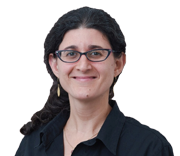A crucial part of tumor formation in cancer is the ability of cancer cells to form new blood vessels to supply their increasing needs. Healing from a wound also requires growing new blood vessels, so this is another part of normal cell biology that goes awry in cancer.
Now a researcher at the University of Texas Southwestern Medical Center is trying to understand this process, called angiogenesis, in an effort to interfere with cancer-associated blood vessels. This could have multiple effects on a tumor, from inhibiting its growth to making drug delivery more efficient.
Khuloud Jaqaman was recruited in 2013 to the department of biophysics at UT Southwestern Medical Center from Harvard Medical School, with the help of a First-Time Tenure-Track Award from CPRIT.
Angiogenesis relies on receptors on a cell’s surface that receive and relay messages. Receptors on the cells that create blood vessels receive messages that encourage existing blood vessels to grow toward the source of the messages, for example, toward a cancer cell. Receptors also receive and relay the messages when it’s time for the blood vessels to stop growing.
Jaqaman studies the organization of these receptors in the cell membrane, for example, how the receptors move and interact with each other, and how their organization affects their ability to receive and relay messages .
In one of her research projects, she has made the novel observation that one receptor involved in inhibiting angiogenesis often clusters on the cell membrane with another protein, called a “downstream effector,” which passes the signal down the line. Imagine a post office loading mail in to a mail truck, which then delivers the mail to the intended recipient. In this case the post office and the mail trucks are together in a cluster, which makes mail, or signals, pass efficiently from one to the next.
At the post office, when the mail comes in, more mail delivery trucks show up to ensure that all mail gets loaded and delivered. In a cell, when the signal to stop new blood vessel formation arrives, more receptors and downstream effectors that pass the signal down the line muster nearby to ensure that the signals get relayed faithfully.
Jaqaman is hoping that a better understanding of how these receptors are organized could lead to better drug development. Receptors, because they are located on a cell’s surface, have become favorite targets for anti-cancer drugs. Jaqaman believes that, using the findings from her lab, drugs could be designed to target more than one receptor at the same time by taking advantage of the receptors’ close proximity to each other on the cell membrane.
Jaqaman uses single-molecule and super-resolution microscopy to study the cell-surface receptors and the signaling molecules that bind to them. Such high-resolution images generate tremendous amounts of data, so to analyze them she is also developing computational tools, which she shares with the larger scientific community.
She and her husband, CPRIT Scholar Gaudenz Danuser, used some of their CPRIT funding to invest in a high-performance computing cluster at UT Southwestern Medical Center to meet the computational needs of their laboratories.
She says the CPRIT funding also enabled her to hire senior lab personnel and purchase the microscopes that make her work possible. “CPRIT has facilitated doing a lot of things that with a typical startup package I wouldn’t have been able to do,” she says.
Jaqaman received her undergraduate degree in physics from Birzeit University, in the West Bank, and her Ph.D. in computational biophysics from Indiana University Bloomington. She was a postdoctoral fellow at the Scripps Research Institute, in La Jolla, Calif., prior to becoming an instructor at Harvard in 2009.
Read Less

